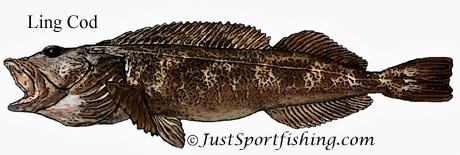|
|

How
to fish for Lingcod
Lingcod occur from southern California to Kodiak Alaska. The Lingcod is most abundant on the coast of northern British Columbia and Alaska. Lingcod are bottom dwelling fish that can be found in depths ranging from 30 feet to over 300 feet. Lings typically forage near underwater structure, reefs, rocky bottoms and kelp beds.
Lingcod have large heads with large mouths armed with canine like teeth. The Lingcod feature a distinct large dorsal fin that spans the entire body of the fish. Most angler caught lingcod are under 20 pounds but lingcod in the 40 to 50 pound range are caught with some regularity.
The Lingcod has a large appetite and will take a large variety of live baits which include herring, anchovies, squid, flounder, cod, greenling, rockfish, shrimp, hake, and other small lingcod. Jigs, shrimp flies, and artificial lures also work well for Lingcod as well as a combination of jigs and lures with a piece of bait attached. Lingcod jigs and lures come in a variety of sizes, shapes, and colors. These heavy lures are designed to reach the bottom quickly and usually sport treble hooks on the bottom of the jig. The jigs and lures can range from solid metal bars to minnow shaped flashers with holographic tape, and time tested diamond jigs. A small piece of bait on the lure can add to your catches.
Fishing with these jigs and lures is simply a matter of lowering your jig or lure until it hits bottom, then bring it up just a couple of cranks of the reel. Raise your rod tip slowly 2 to 3 feet and quickly drop the tip, just keep repeating this. This jigging for Lingcod can be done while anchored or while drifting your boat over the fishing area.
Fishing for Lingcod can be done with a variety of rod and reel combos but a 6 1/2 to 7 1/2 foot medium action rod with a star drag conventional saltwater fishing reel is good for most locations. Reels can be spooled up with 300 to 400 yds of 20 to 40 lb mono or braided line. Braided line has less resistance in the water and requires less weight to get down to the bottom. To the end of your line tie a 50 lb snap swivel.
There are two angles to thought when it comes to leaders. One problem is Lingcod hang out in rocky bottoms where snags are abundant, the other is their sharp teeth. Some like a 16 to 24 inch 40 pound steel leader. The idea to this train of thought is that the lingcod's sharp teeth wont cut the leader, also should you get a minor snag on the bottom you can muscle your jig off the snag, trouble is there is a good chance your line breaks somewhere between the bottom of the ocean and your rod tip. The other angle is using a sacrificial 25 pound mono leader that if you get a snag it's the leader that breaks and you save your line and swivel, but loose the lure.

|
JustSportfishing.com

|


